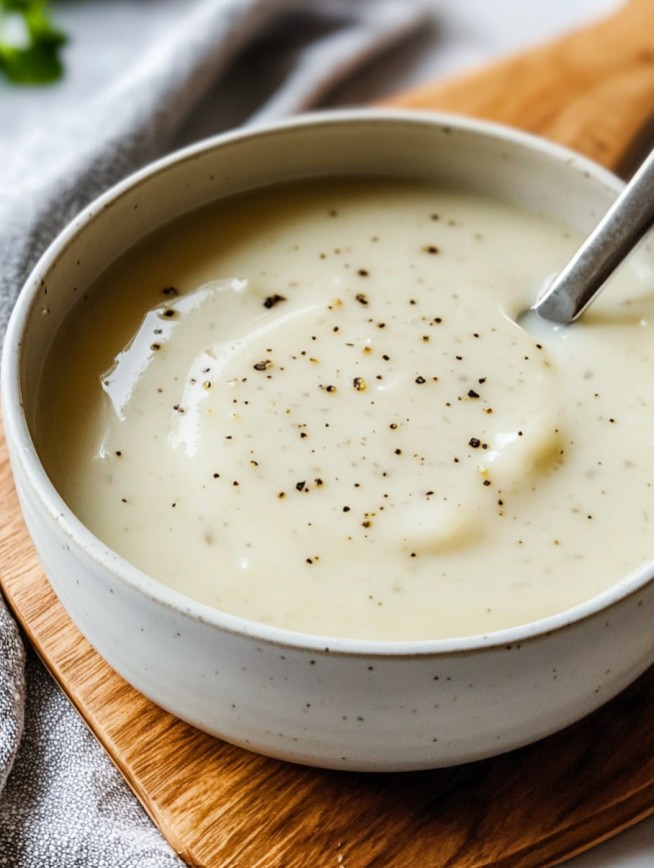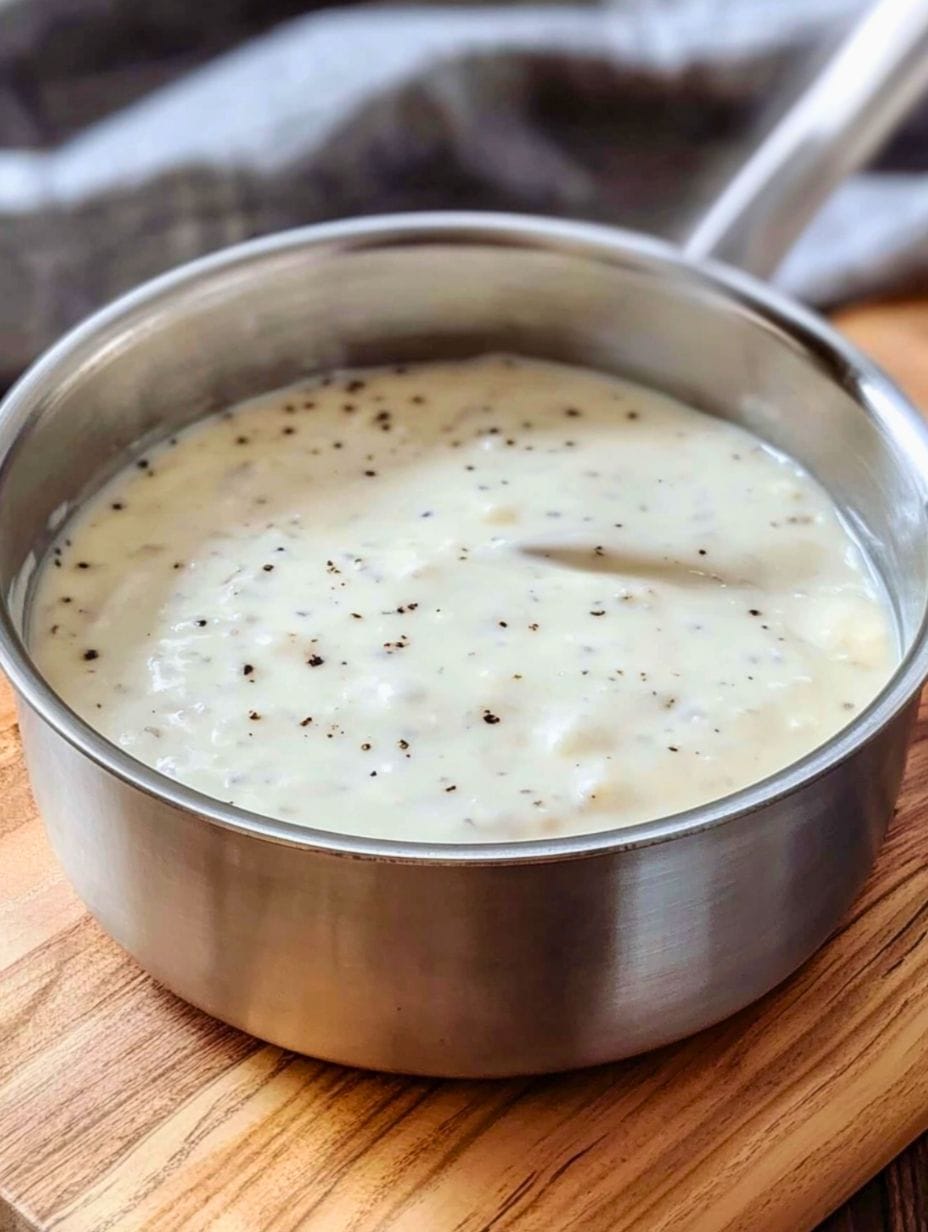There’s nothing quite like a rich, creamy white gravy to bring a touch of comfort to the table. This foolproof recipe is designed for beginners and guarantees a smooth, flavorful result every time. This simple, made-from-scratch gravy is a game-changer.

Save This Recipe! 💌
We'll email this post to you so you can cook it later!
Cuisine: American
Prep Time: 5 minutes
Cook Time: 15 minutes
Total Time: 20 minutes
Servings: 8
Here’s a great video that shows the process of making a simple white gravy.
Why You’ll Love Making It
- The Ultimate Comfort Food Staple: This is the classic, rich, and creamy gravy you know and love, perfect for biscuits, fried chicken, or mashed potatoes.
- Made with Pantry Basics: It requires just five simple ingredients that you likely already have in your kitchen.
- Ready in Under 20 Minutes: A quick and delicious addition that elevates any breakfast, lunch, or dinner.
- Foolproof and Lump-Free: Our step-by-step instructions, especially the method for adding milk, are designed to ensure a perfectly smooth gravy every time.
- Easily Customizable: You can effortlessly adjust the thickness to your preference and add other seasonings to make it your own.
- Incredibly Versatile: This gravy is the perfect finishing touch for countless dishes, making it a must-have recipe in your culinary arsenal.

Ingredients
- 5 Tbsp. unsalted butter: Using unsalted butter allows you to control the final saltiness of the gravy. If you only have salted butter, reduce the added salt by half and adjust to taste at the end. For extra flavor, you can substitute butter with bacon grease or sausage drippings.
- 5 Tbsp. all-purpose flour: This is the thickening agent. The 1:1 ratio of fat to flour creates a perfect roux, which is the foundation of a great gravy.
- 2–3 cups milk: Whole milk will yield the creamiest, richest gravy. However, 2% milk also works well. For best results, use milk that is at room temperature or slightly warmed to help prevent lumps when it’s added to the hot roux.
- 1/2 tsp. salt: This enhances all the flavors. Start with this amount and add more at the end if needed.
- 1/4 tsp. black pepper: Freshly ground black pepper provides the best, most aromatic flavor. Feel free to add more for a pepper-forward gravy.
Instructions
Step 1: Make the Roux
In a medium saucepan, melt the butter completely over medium heat. Once the butter is melted and bubbling slightly, sprinkle in the flour. Immediately begin whisking continuously. Cook the mixture, still whisking, for about 1 to 2 minutes. The mixture, known as a roux, will transform from a clumpy paste into a smoother, slightly golden base. This essential step cooks out the raw flour taste and is the key to a smooth, lump-free gravy.
Step 2: Slowly Add the Milk
To ensure a perfectly smooth consistency, temporarily remove the pan from the heat. Slowly drizzle in about ¼ cup of the milk while whisking constantly and vigorously until the mixture is completely smooth. It will thicken up quickly into a paste. Add another ¼ cup of milk and continue to whisk until it is fully incorporated and smooth again. Once the base is smooth, slowly pour in the remaining 1 ½ cups of milk in a steady stream, whisking continuously. Stir in the salt and pepper.
Step 3: Simmer & Thicken
Return the saucepan to the stove over medium heat. Bring the mixture to a gentle simmer, but do not let it come to a rolling boil. Continue to stir or whisk frequently to prevent lumps from forming and to keep the bottom from scorching. As it simmers, the gravy will thicken to a glossy, velvety texture, which should take about 2–3 minutes. You’ll know it’s ready when it coats the back of a spoon.
Step 4: Adjust the Consistency
The gravy will continue to thicken as it cools. For a thinner consistency, gradually whisk in more milk (up to 1 additional cup) until it reaches your desired thickness. Let it heat through for another minute without boiling.
Step 5: Taste & Finish
Taste the finished gravy and adjust the seasoning if needed, adding more salt or pepper. If any lumps have managed to form, you can easily strain the gravy through a fine-mesh sieve for the smoothest possible texture. Serve immediately over biscuits, mashed potatoes, fried chicken, or any dish that calls for a rich, creamy sauce.
FAQs
How do I fix lumpy gravy?
The best way is prevention by adding the milk slowly while whisking. However, if you end up with lumps, whisk vigorously off the heat. For very stubborn lumps, you can use an immersion blender directly in the pot or carefully transfer the gravy to a regular blender and pulse until smooth. Straining through a sieve is also a great final option.
Can I make this gravy without butter?
Absolutely! You can achieve an even richer, more savory flavor by substituting the butter with an equal amount of bacon grease or sausage drippings. If you want to use oil, a neutral-flavored one like vegetable or canola oil is your best bet.
Can I make this gravy ahead of time?
Yes! This gravy is perfect for making ahead. You can prepare it up to 3 days in advance and store it in an airtight container in the refrigerator. It will thicken considerably when chilled. To reheat, warm it gently in a saucepan over low heat, whisking constantly. You will likely need to whisk in a little more milk to bring it back to its original smooth consistency.
How do I fix gravy that is too thin?
If your gravy isn’t as thick as you’d like, let it simmer over medium-low heat for a few more minutes, as it will reduce and thicken further. If it’s still too thin, you can create a “slurry” by whisking 1 tablespoon of flour with 2 tablespoons of cold water in a separate small bowl until smooth. Then, slowly whisk this slurry into the simmering gravy until it reaches the desired thickness.
How do I store leftover gravy?
Store any leftovers in an airtight container in the refrigerator for up to 4 days. Reheat gently on the stovetop, adding a splash of milk to thin it out as needed.

Simple White Gravy
Ingredients
- 5 tbsp Unsalted Butter
- 5 tbsp All-purpose Flour
- 2–3 cup Milk
- ½ tsp Salt
- ¼ tsp Black Pepper
Instructions
- In a medium saucepan, melt the butter completely over medium heat. Once the butter is melted and bubbling slightly, sprinkle in the flour. Immediately begin whisking continuously. Cook the mixture, still whisking, for about 1 to 2 minutes. The mixture, known as a roux, will transform from a clumpy paste into a smoother, slightly golden base. This essential step cooks out the raw flour taste and is the key to a smooth, lump-free gravy.
- To ensure a perfectly smooth consistency, temporarily remove the pan from the heat. Slowly drizzle in about ¼ cup of the milk while whisking constantly and vigorously until the mixture is completely smooth. It will thicken up quickly into a paste. Add another ¼ cup of milk and continue to whisk until it is fully incorporated and smooth again. Once the base is smooth, slowly pour in the remaining 1 ½ cups of milk in a steady stream, whisking continuously. Stir in the salt and pepper.
- Return the saucepan to the stove over medium heat. Bring the mixture to a gentle simmer, but do not let it come to a rolling boil. Continue to stir or whisk frequently to prevent lumps from forming and to keep the bottom from scorching. As it simmers, the gravy will thicken to a glossy, velvety texture, which should take about 2–3 minutes. You'll know it's ready when it coats the back of a spoon.
- The gravy will continue to thicken as it cools. For a thinner consistency, gradually whisk in more milk (up to 1 additional cup) until it reaches your desired thickness. Let it heat through for another minute without boiling.
- Taste the finished gravy and adjust the seasoning if needed, adding more salt or pepper. If any lumps have managed to form, you can easily strain the gravy through a fine-mesh sieve for the smoothest possible texture. Serve immediately over biscuits, mashed potatoes, fried chicken, or any dish that calls for a rich, creamy sauce.
Save This Recipe! 💌
We'll email this post to you so you can cook it later!







can i use almond milk in this or will it mess the taste up? Never made gravy before n wanna try it out.
Just followed this to make gravy for the first time. Turned out pretty good. Thanks Sandra Clare for the easy steps!
Hmm, I’ve made gravy a million times and never needed to adjust the consistency. You sure about that step, Sandra Clare?
i guess making gravy isn’t as hard as i thought, gonna give it a try.
Wow, making gravy sounds fun! Can’t wait to try this weekend.
why do we start with a roux? is that a must?
Starting with a roux is key for thickening and flavor. Totally a must.
When I try to make roux, it turns into ‘Roux-oh!’ Might need more practice, or maybe a less fire alarm-friendly kitchen.
Tried this, burned the roux, and everything went south. Gravy making is not for me, I guess.
Back in my day, we learned gravy making from our parents, not the internet. But nice to see the tradition continues.
Is there a way to make this gravy low fat? Trying to keep it healthy but craving comfort food.
any chance i can make this gravy vegetarian friendly?
so you’re telling me I gotta cook now to eat? what’s next, growing my own food?
I must say, making gravy without butter is sacrilege. Butter gives it that rich flavor you can’t replicate.
Love finding recipes that remind me of home. This gravy is gonna be a hit.
Your roux method is sound, but real craftsmanship is in the seasoning. Don’t forget salt dynamics.
Great, just what the world needed, another gravy recipe. Because the internet definitely lacks those.
If my gravy turns out lumpy, can I just call it artisanal and get away with it?
Roux is the beginning of so many wonderful things, much like a blank page ready to be filled with words. Excited to start this culinary chapter.
finally figured out my gravy always tasted weird, wasn’t cooking the roux long enough. thx for the tip!
has anyone tried making this with a veggie broth instead of milk? curious if it works
what if i’m lactose intolerant and my gravy ends up thicker than my milk? asking for a friend.
always thought making gravy was a science. turns out it’s more like an art. cool beans.
Can I substitute something for the flour to make it gluten-free? Wheat doesn’t sit well with me.